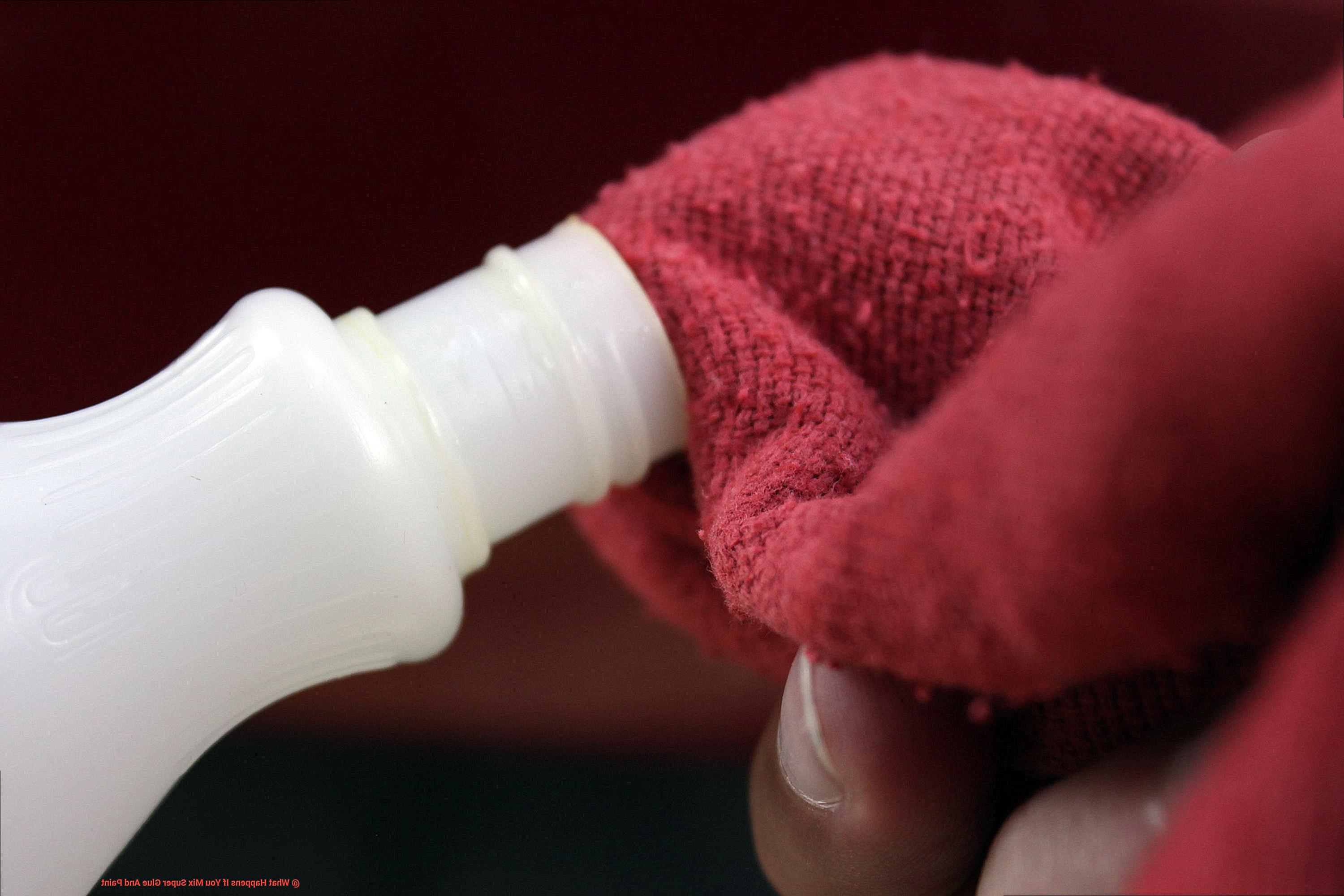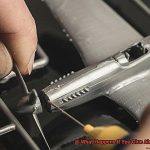Are you a DIY fanatic or an artist looking to experiment with new materials? Have you ever pondered the possibility of mixing super glue and paint? While it may sound like an unusual idea, it’s not as far-fetched as you might assume. In fact, many people have tried this unconventional combination, and the outcomes are nothing short of fascinating.
Super glue is a popular adhesive known for its rapid drying and robust bonding properties. Meanwhile, paint is a versatile medium that artists use to express their creativity. Mixing these two substances may seem like a recipe for disaster, but there are potential benefits to be had from this unique pairing.
In this blog post, we’ll delve into what happens when you mix super glue and paint. We’ll explore the chemical reaction that occurs when these two substances come into contact and discuss how artists and DIY enthusiasts can take advantage of this blend. Additionally, we’ll examine any potential risks or precautions that need to be taken when mixing these substances.
So hold onto your hats and get ready to learn something new and exciting. Whether you’re an artist or a DIY enthusiast, this post will provide valuable insights into what happens when you mix super glue and paint.
What is Super Glue?
Contents
Super Glue, also known as cyanoacrylate adhesive, is a powerful and fast-acting adhesive that has a wide range of applications. Its discovery can be traced back to 1942 when Dr. Harry Coover was working on creating a clear plastic for gun sights during World War II. However, he soon realized that the substance was too sticky and difficult to handle. Little did he know that this “mistake” would lead to the creation of one of the strongest adhesives available today.
Super Glue works by creating a chemical reaction with moisture. When it comes into contact with water or even the moisture in the air, it polymerizes and hardens into a strong bond almost instantly.
This makes it perfect for emergency repairs or quick fixes. The adhesive’s strength is unparalleled – it can bond various materials such as metal, plastic, wood, ceramic, and even skin (although medical-grade cyanoacrylate adhesives should be used for wound closure).
Although Super Glue is versatile and can bond almost anything, it should not be mixed with water-based paint as it will cause the paint to curdle or clump together. Similarly, it should not be mixed with oil-based paint as the solvents in the paint can dissolve the glue and render it ineffective.
When using Super Glue, it is essential to keep the cap tightly closed when not in use to prevent any moisture from getting inside. It is also recommended to use the adhesive sparingly as excess glue can be difficult to remove.
What is Paint?
It’s not just a simple mixture of colors, but a complex substance made up of various components that come together to produce a protective and decorative coating on surfaces. Let me share my expertise on the topic with you.
There are four main components that make up paint: pigments, binders, solvents, and additives. Pigments are responsible for the color of the paint, while binders keep the pigment particles together and help them adhere to the surface being painted. Solvents make it easier to apply the paint by dissolving the binder and pigments, while additives enhance certain properties of the paint like durability, drying time, and texture.
Different types of paint are available in the market, each with unique properties and uses. Oil-based paints use mineral spirits or turpentine as solvents and take longer to dry than water-based paints which use water as a solvent. Latex paint is water-based but has added latex for increased flexibility and durability. Enamel paint is oil-based with added varnish for increased durability and shine. Spray paint is also popular for quick and easy application.
Paint can be applied using various methods like brushes, rollers, or sprays depending on the surface being painted and the type of paint being used. While it is commonly used for decorative purposes, paint also provides protection against weathering and corrosion.
However, mixing super glue with paint can lead to unintended consequences that may affect its effectiveness in protecting and decorating surfaces. The glue may cause the paint to become thicker or gummy, making it difficult to adhere properly to the surface being painted. Moreover, it may affect the drying time of the paint, leading it to take longer than usual to dry or not dry at all.
Different Types of Paint and Glue
Mixing different types of paint and glue can result in unique outcomes, but it’s important to consider the properties and characteristics of each material before combining them. In this article, we’ll explore the various types of paint and glue available and how they can affect the outcome when mixed together.
Types of Paint
- Acrylic Paint: This water-based paint is popular due to its quick drying time and easy color blending. It also has good adhesion properties, allowing it to stick well to a variety of surfaces.
- Oil-Based Paint: Known for its durability and resistance to wear and tear, oil-based paint is a favored choice for high-traffic areas. However, it can take a long time to dry and can be difficult to clean up.
- Enamel Paint: This type of paint provides a glossy finish and is resistant to wear and tear, making it a popular choice for painting metal surfaces.

Types of Glue
- Super Glue: Also known as cyanoacrylate adhesive, this fast-drying adhesive bonds almost instantly. It’s commonly used for small repairs and projects.
- Epoxy Glue: This two-part adhesive requires mixing before use but provides a strong bond for various surfaces.
- PVA Glue: Also known as white glue or school glue, this water-based glue is commonly used in arts and crafts projects. It dries clear and can be easily cleaned up with water.
Mixing Paint and Glue
When mixing super glue and paint, it’s vital to consider the properties of both materials. Acrylic paint tends to mix well with super glue, creating a strong bond between surfaces. However, oil-based paint may not mix as well with super glue due to its slow drying time. Enamel paint can also be tricky to mix with super glue due to its glossy finish.
It’s essential to note that some combinations may not bond properly or could even react negatively with each other. Therefore, it’s best to avoid mixing super glue with any type of paint as the strong adhesive properties of the super glue could interfere with the drying process of the paint or cause other issues.
Mixing Super Glue and Water-Based Paint
But when it comes to mixing super glue and water-based paint, the potential dangers far outweigh any potential benefits. These two substances have vastly different chemical properties, making it a recipe for disaster.
Super glue, also known as cyanoacrylate adhesive, is a fast-drying, strong adhesive that creates a permanent bond. Water-based paint, on the other hand, uses water as a solvent instead of oil. When these two substances are mixed together, the result can be unpredictable and potentially disastrous.
The biggest danger of combining super glue and water-based paint is that the glue will react with the water in the paint and begin to harden almost immediately. This reaction can cause the paint to become lumpy or gritty, making it difficult to apply smoothly. Additionally, the glue may create a white film on the surface of the paint, ruining the finish.
But that’s not all – mixing super glue and water-based paint can even create a potentially dangerous situation. If the glue is applied to a porous surface such as fabric or skin, it can cause extreme heat and even burns. In some cases, it may even start a fire if applied to flammable surfaces.
To avoid any potential DIY disasters, it’s best to keep super glue and water-based paint separate and apply them in separate layers. This will ensure that each substance performs as intended and that you achieve the desired result without any unwanted side effects.
Mixing Super Glue and Oil-Based Paint
Mixing two incompatible substances can lead to disastrous outcomes, and this is especially true when it comes to combining super glue and oil-based paint.
Super glue, also known as cyanoacrylate adhesive, is a popular adhesive due to its quick-drying and strong bonding properties. It’s frequently used for household repairs and DIY projects.
Oil-based paint, on the other hand, is a type of paint made up of pigments suspended in oil and is commonly used in painting projects. Although both of these substances may seem harmless on their own, they can create a dangerous situation when mixed.
When super glue comes into contact with oil-based paint, it can cause the paint to soften and eventually dissolve. This chemical reaction can occur quickly, leading to the formation of a sticky and gooey substance that is difficult to remove.
However, that’s not all; the chemical reaction between super glue and oil-based paint can also produce toxic fumes that can be harmful when inhaled. These fumes can cause respiratory problems, headaches, dizziness, and even nausea.
To avoid any harm or damage, it’s best to avoid mixing super glue and oil-based paint altogether. However, if you accidentally mix them, take precautions to protect yourself from the toxic fumes. Wear protective gear such as gloves and masks and avoid inhaling the fumes at all costs. Additionally, you should clean up the area immediately using a solvent like acetone or mineral spirits.
Creating a Hardened Plastic-Like Substance with Super Glue and Paint
Look no further than combining super glue and paint. By mixing equal parts of super glue and acrylic paint in a container, you can create a strong, durable, and water-resistant surface that can be shaped, sanded, and painted to fit any desired form.
To make this substance, start by stirring the mixture thoroughly until it becomes a smooth consistency. Keep in mind that the type of paint you use will affect the final product. We recommend using acrylic paint, thanks to its fast-drying and water-resistant properties.
Once you’ve mixed the two ingredients together, you can apply the substance to a variety of surfaces such as wood, metal, plastic, or even fabric. Be aware that it’ll harden quickly within minutes, so work fast when applying it. Once it dries, you can sand it down to a smooth finish and even paint over it if desired.
This technique is used in creating props for movies and theater productions, making unique jewelry, sculptures, and other decorative items. The possibilities are endless with this versatile substance.
It’s essential to note that when working with super glue and paint, they can be toxic when mixed together. So when handling the mixture, make sure to wear protective gear like gloves and a mask.
Avoiding Unfavorable Results When Mixing Super Glue and Paint
Before you start, there are some crucial things to keep in mind to ensure that your project turns out perfectly. As an expert in this field, I’ve compiled a comprehensive list of tips to help you create the perfect mixture without any unfavorable results.
First and foremost, remember that super glue dries in the blink of an eye, so it may not be the best option for paints that require more time to dry. Additionally, the chemical composition of super glue can cause some paints to become brittle or crack over time. Therefore, it’s essential to choose the right kind of paint when mixing with super glue.
Water-based acrylic paints are an excellent choice since they are less likely to react negatively with the glue. When mixing the two substances, start with small amounts and gradually add more paint or glue as needed. This technique will help you achieve the desired texture and consistency while avoiding material wastage.
Preparing the surface is also a critical factor in ensuring successful adhesion. Ensure that the surface is free of any debris or dust that can affect the bonding of the glue. Sanding down the surface slightly will create some texture that will help the paint adhere better.
Lastly, remember that super glue is challenging to remove once it has dried. Protect any surfaces or areas that you don’t want painted or glued using masking tape or other protective materials. If you accidentally get glue where you don’t want it, use a solvent like acetone or rubbing alcohol to remove it before it dries.
VlXPOMGFrWI” >
Conclusion
To wrap things up, the combination of super glue and paint can be a fascinating experiment for those who love DIY projects or artistic expression. Super glue is known for its rapid-drying and strong bonding properties, while paint is a versatile medium that artists use to bring their visions to life. However, it’s crucial to understand the chemical reaction that occurs when these two substances come into contact before embarking on any project.
When mixing water-based or oil-based paint with super glue, disastrous outcomes can ensue due to their vastly different chemical properties. The result may be lumpy or gritty paint that’s challenging to apply smoothly, with a white film ruining the finish. Even worse, mixing super glue with oil-based paint can create toxic fumes that are harmful when inhaled.
Despite the potential pitfalls, there are benefits to this unusual pairing. By combining equal parts of super glue and acrylic paint in a container, you can create a durable surface that’s both water-resistant and easily shaped, sanded, and painted as desired.
Before attempting any project involving super glue and paint together, it’s essential to carefully consider both materials’ properties. Choose the right kind of paint when mixing with super glue and prepare the surface correctly before applying any mixture. Keep in mind that excess glue is difficult to remove once it dries.
In conclusion, by following these tips and taking necessary precautions when working with this unconventional combination of materials, DIY enthusiasts and artists alike can achieve incredible results.






